Oceanography & Fisheries - Juniper Publishers
Abstract
This paper reviewed food and feeding habits of six
Synodontis species in the African freshwaters and determined diet with
respect to size (ontogenetic shift) and season. The variety of food
substances found in the stomach of various Synodontis species from
different African waters showed that the species are omnivorous feeders
as the diet covers a wide spectrum of food ranging from various types of
plankton to invertebrates, plants and small fish. The importance of
phytoplankton, zooplankton and insects declined steadily with size of
fish while the importance of macrophytes, fish fry and fish scales
increased with size of fish. This review showed abundance of food for
Synodontis fish in both the months of wet and dry seasons. The high
diversity of the food composition in the stomachs of Synodontis fish
species indicates a wide adaptability to the food and feeding habit in
the water bodies in which they live. The scientific information obtained
in this review is important for understanding of the trophic position
of the Synodontis fish species in order to maintain proper balance and
dynamics of the species in the African freshwaters.
Keywords: Synodontis; Feeding; Diet shift
Introduction
Fishes of the genus Synodontis (family Mochokidae)
are commonly referred to as squeakers or upside-down catfishes. They are
widely distributed in African freshwaters ranging from the Nile basin,
Chad, Niger and West African regions. The genus has over 112 species
some of which are commercially important [1]. The different Synodontis
species vary in commercial status in different locations, many are
important food fishes, and some have attractive hues and exhibit
behavioral characteristics that make them potential ornamental
candidates [2]. Synodontis are highly valued food fishes in Benin and
contribute a significant proportion to the fishery of the rivers [3].
The two species, S. victoriae and S. afrofischeri, occur in Lake
Victoria [4]. The smaller sized species S. afrofischeri tends to inhabit
water < 20 m deep while S. victoriae is more numerous in deeper
waters. S. victoriae are prized ornamental because of their striking
pigmentation body patterns and upside-down swimming behavior [5,6].
Furthermore, like any other fish they play an important role by
providing food for human consumption and employment opportunities for
communities within Lake Victoria basin.
Synodontis schall (Bloch & Schneider) is
reported as the most tolerant species to adverse environmental
conditions in the genus and it has the widest distribution in Africa
[7]. It is commercially important in the inland waters of West Africa
and is one of the
species that can be seen in the fish markets throughout the year.
Synodontis resupinatus Boulenger 1904, occur throughout most of the
freshwaters of the Sub-Saharan Africa and the Nile River [8]. Synodontis
nigrita (Curvier and Valenciennes, 1864) is one of the dominant and
endemic Mochokids of Nigeria inland waters [9]. It supports a thriving
commercial fishery in many West African Countries. S. nigrita is noted
as a palatable fish with high protein content and is in great demand,
however, its armor-like head makes it bony in structure [10]. Synodontis
membranaceus has excellent flavor of flesh either fresh or dried as
human food and perform important trophic role in their habitat where
they serve as food for other commercially important fishes and hence the
need for their conservation [11]. This paper reviewed food and feeding
habits of six Synodontis species in the African freshwaters and
determined diet with respect to size (ontogenetic shift) and season. An
understanding of the food and feeding habits of fish is important for
its management and successful culture.
Food and feeding habits of Synodontis fishes
Food Composition
The frequency of occurrence of food items in
stomachs of S. nigrita, S. schall, S. resupinatus, S. membranaceus, S.
victoriae and S. afrofischeri from different African waters are
summarized in Table 1. In Ouémé River, Benin [3], macrophytes and algae
were the most preferred food items by S. schall and S. nigrita.
The proportion of eggs and fish scales was more important in
the stomach contents of S. schall (40.4%) compared to that of S.
nigrita (1.6%). However S. schall preferred molluscs, nematodes
and insects than S. nigrita. Synodontis schall in Lake Chamo,
Ethiopia [1], zooplankton (Copepod and Cladocera) had the
highest occurrence in diet followed by fish scales (35.0%) and
Diptera insects (31.1%). S. resupinatus in River Niger, Nigeria [2]
majorly fed on macrophytes (41.7%), sand grains (29.2%) and
algae (18.2%). In Ogobiri River, Nigeria (Allison & Youdubagha,
2013), the frequency of occurrence of the most important food
items consumed by S. membraneceus were Cladocera (30.5%),
Insects (30.9%) and Copepods (29.6%). For S. victoriae in Lake
Victoria, the most ingested food items included Caridina nilotica
(57.1%), Insects (22.3%), Fish remains (19.3%), Rastrineobola
argentea (17.9%) and detritus (13.9%). The major food items
for S. afrofischeri in Lake Victoria included R. argentea (34.0%)
and insects (23.1%), followed by fish remains, worms, molluscs,
haplochromines and algae.
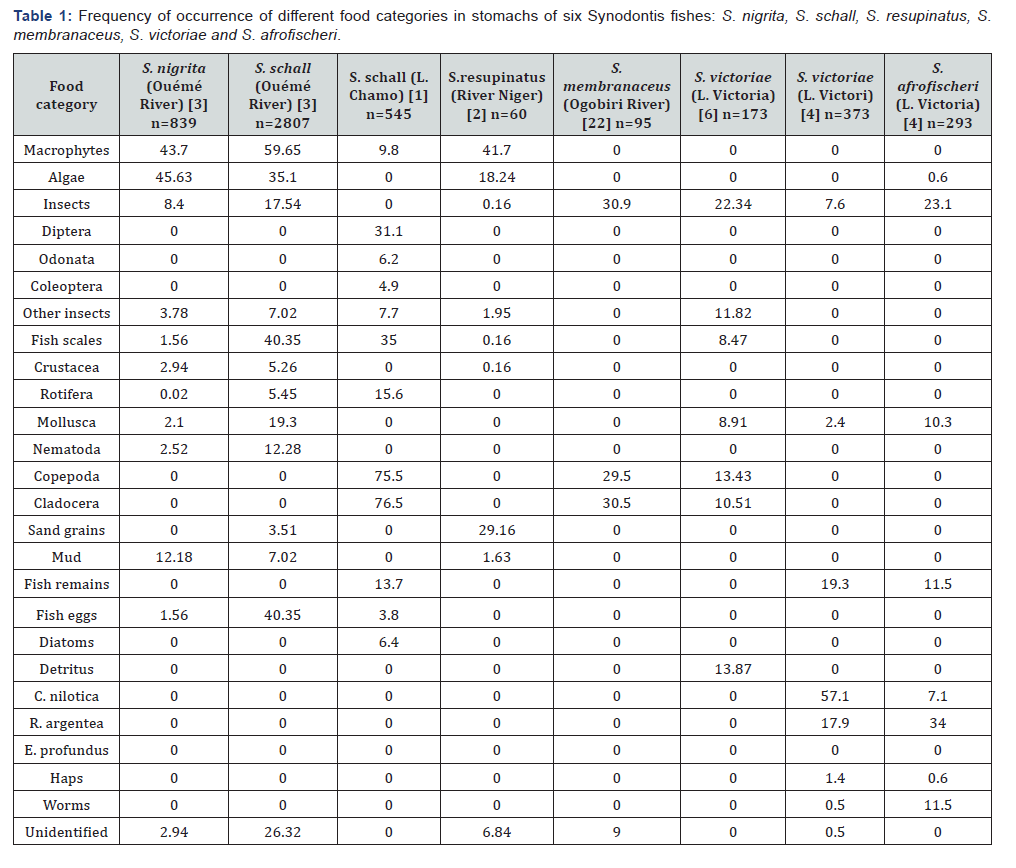
Ontogenetic diet shift
Ajah et al., 2006 analyzed 100 specimens of S. nigrita from
Cross River Estuary in Nigeria and found that juveniles (12–20
cm TL) were predominantly mud dwelling, feeding on nematode
worms (91%), diatoms (7%) and crustaceans (1%), whilst adults
(21–25 cm TL) were found to be predominantly planktotrophic,
their diets comprising 50% diatoms and 50% crustaceans
(Figure 1). S. membranaceus from Jebba Lake in Nigeria (Olufemi,
2007), showed a progression from detritivorous diets in fish
below 20 cm SL through a transitional planktivorous diets in fish
between 20-27 cm SL to a predominantly insectivorous diets
in fish above 27 cm SL (Figure 2). The figure further shows the
relative importance index of Aspatharia, plant parts, seeds and
Coleopteran larvae increased with increase in fish size. For S.
schall from Lake Chamo in Ethiopia, the importance of diatoms zooplankton and insects declined as the size of fish increased,
whilst that of scales increased with increase in fish size (Figure
3). Zooplankton contributed 68.1% of the food consumed by S.
schall of size 10.0-14.49 cm FL, but they contributed only 12.5%
of the total volume of food consumed in 35.0- 39.9 cm FL size
class. Insects constituted 22.0% of the total volume of food
consumed by 10.0-14.9 cm FL, but their contribution declined
sharply with the size of the fish and constituted only 3.8% of the
total volume of food eaten by the 35.0-39.9 cm group. No diatoms
were consumed by fish greater than 25 cm FL size class. On the
other hand, the volume of fish scales, fish fry and macrophytes
consumed by S. schall increased with size. No fish scales were
consumed by 10.0-14.9 cm FL size class. In 15.5-19.9 cm FL size
class, fish scales contributed only 5.5% of the total volume of
food eaten, but in 35.0- 39.9 cm FL size class the contribution
was 50.6% of the total volume eaten.
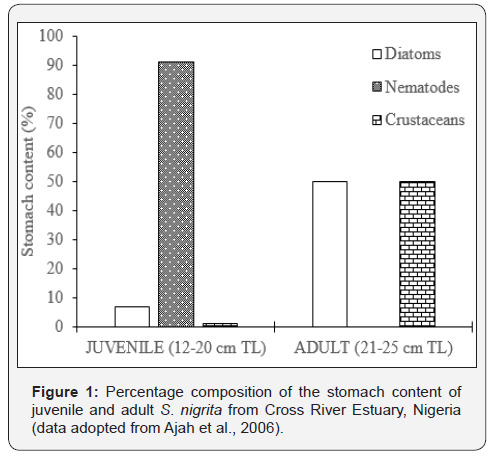
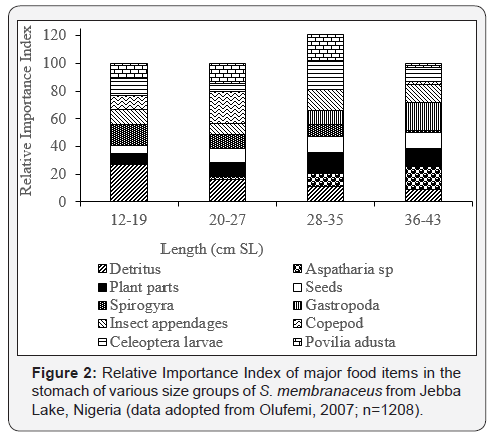
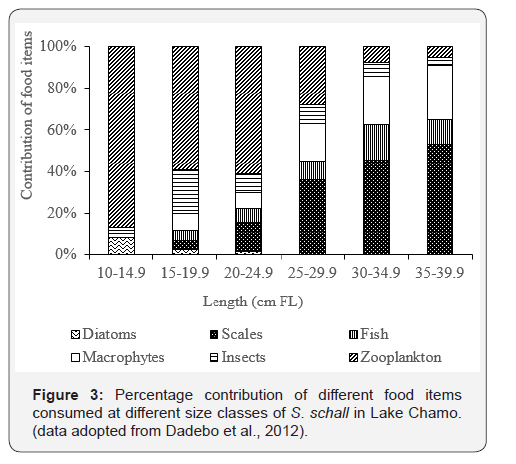
Feeding in relation to season
S. membranaceus from Jebba Lake, Nigeria extensively
consumed detritus, P. adusta, coleopteran larvae, copepods,
seeds and plant parts during the rainy season (Figure 4),
whilist it consumed more gastropds, Spyrogyra and Aspatharia
during dry season. For Synodontis victoriae, Plant detritus
(Index of preponderance, Ip = 24.0%) and Copepoda (Ip =
19.3%) dominated the diet in the dry season (Figure 5), while
Chironomids (Ip = 24.0%) dominated the diet during the rainy
season.
Discussion
The variety of food items found in the stomach of six
Synodontis species from different African freshwaters shows
that the species are omnivorous feeders as the diet covers a
wide spectrum of food ranging from various types of plankton
to invertebrates, plants and small fish (Table 1). This agrees with
the finding of Lauzanne (1988) who considers the Synodontis
genus as eclectic. This high diversity of the food composition of
Synodontis species indicates a wide adaptability to the habitats
in which they live. This is an important strategy for survival and
an advantage over the fish species competing for a specific food
item [12,13]. A clear morphological explanation for its feeding
versatility may be due to the ventral location of the mouth of
Synodontis species which encourages a detritivorous mode of
feeding while the simple horny structures around the mouth
enable it to adapt to filter feeding. These structures also help
Synodontis to gnaw at any hard plant tissue which form part of
its rich diet [14].
The diversity in prey preference of fish in all the size
categories could be due to partitioning of food resource in a
bid to avoiding intraspecific competition. This plasticity in
diet composition of Synodontis species reflects the availability of preferred prey organisms within a niche. The same reason
could also be advanced for the progressive decline or increase
in relative importance of the food items, as the fish grew older
(Figure 1-3). The establishment of detritus as the main food
items in the juveniles (12-19 cm SL) suggests a filter feeding
habit. The ventral location of the mouth encourages detritivores
mode of feeding. However, the inclusion of varied and large size
food items in larger specimens indicated a switch from a filter
feeding to increased reliance or active predation on appropriately
sized prey that are probably selected individually. This may
have been informed by the development of strong pharyngeal
teeth and jaws. The diversity thus offered in the dominant food
items as well as mode of feeding agreed with Fagbenro [15]. The
switch from filter feeding to a predatory habit with increasing
fish size is a common phenomenon in catfishes [16,17]. Also,
the progression from detritivorous diets through a transitional
planktivorous phase to active predation on relatively biggersized
prey with increasing fish size agrees with the observations
of Ochieng [18] and Fagbenro [15] that catfishes show a high
degree of plasticity in their diets utilizing different food items
as they grow.
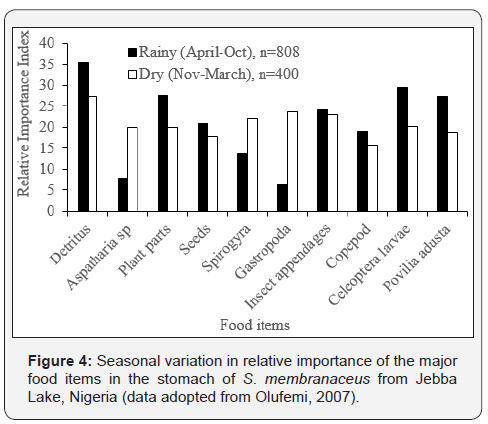
The transition from insectivorous diets in the rainy season
to benthophagus diet in the dry season (Figures 4 & 5) is an
indication of food selectivity depending on the relative abundance
of available food as well as the size spectrum. Changes in fish diet
associated with size and in relation to seasonal availability have
been reported by Odum & Anuta [19] and Saliu [20]. The increase
in the quantitative composition of insects and their parts during
the rainy season is attributed to the life history patterns of the
insects and probably to the foraging efficiency of Synodontis
species [21]. Detrital particles together with allochthonous
food such as plant seeds washed by flood from the surrounding
vegetation into the water bodies might have been responsible
for the high incidence of each of these diets during the rainy
season. The feeding on plant detritus and copepods during the
dry season could be attributed to the poor food resources at this
period and the dominance of Chironomids may be linked to the
emergence of insects during the wet season [22,23].
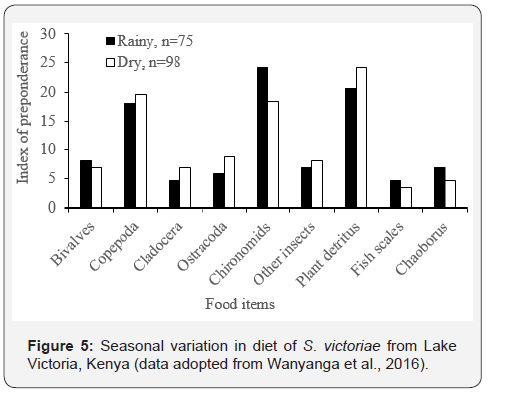
Conclusion
The feeding behavior of different Synodontis species from
different African waters shows that the species are omnivorous,
feeding on a wide variety of food items. The importance of
phytoplankton, zooplankton and insects declined steadily
with size of fish while importance of macrophytes, fish fry
and fish scales increased with size of fish. This review showed
abundance of food for Synodontis fish in both the months of wet
and dry seasons. The high diversity of the food composition
in the stomachs of Synodontis fish species indicated a wide
adaptability to the food and feeding habit in the water bodies
in which they live. The scientific information obtained in this
review is important for understanding of the trophic position of
the Synodontis fish species in order to maintain proper balance
and dynamics of the species in the African freshwaters.
To know more about Oceanography & Fisheries
Click here: https://juniperpublishers.com/ofoaj/index.php
To know more about Juniper Publishers
Click here: https://juniperpublishers.com/index.php





No comments:
Post a Comment